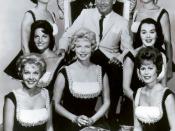Young children and adolescents are very susceptible to the effects of television programming. In the present generation of children, the prominence of television in everyday life is increasing constantly. There have been many studies on the effects of television on the growth of children. The average child or adolescent watches three hours of television a day. At this rate, by the age of seventy, an average person watches seven to ten years' worth of television. The time that a child devotes to the screen causes them to replace other activities that are important to growth, such as reading, exercising, or interaction with other children.
Since children are more vulnerable to the messages that are seen on television, their behavior and perception of the world is affected. In a National Television Violence Study, which went on for three years, it was found that almost two thirds of all programming contains violence and most of it comes from children's programs. This violence is usually made to look appealing and usually goes unpunished. This can have effects on violence and aggressiveness, performance in school, self-image, nutrition, dieting, and drug use and abuse.
Along with violence, television programs also contain large amounts of references to cigarettes, alcohol, and other drugs. Sexual imagery and innuendoes are also prominent on television. This can cause an elevation of curiosity among children. The television environment also seems to be causing adolescents to mature more rapidly. They are bombarded with programming that depicts life as a young adult, which can cause them to mimic those actions.
Besides the negative effect of television, there are some beneficial programs that promote positive social behaviors, such as sharing, manners, and cooperation. There are also educational programs, though they are rarely watched because of the lack of excitement and action. Studies...


